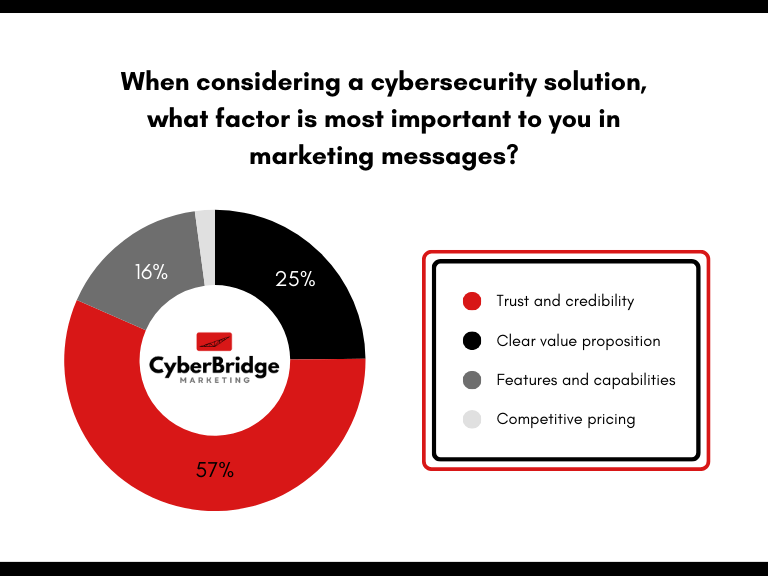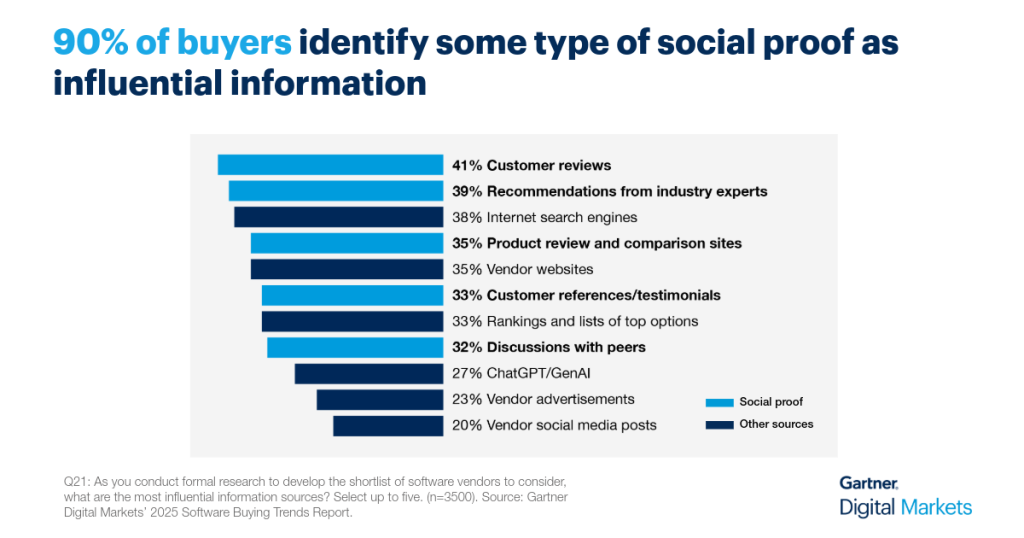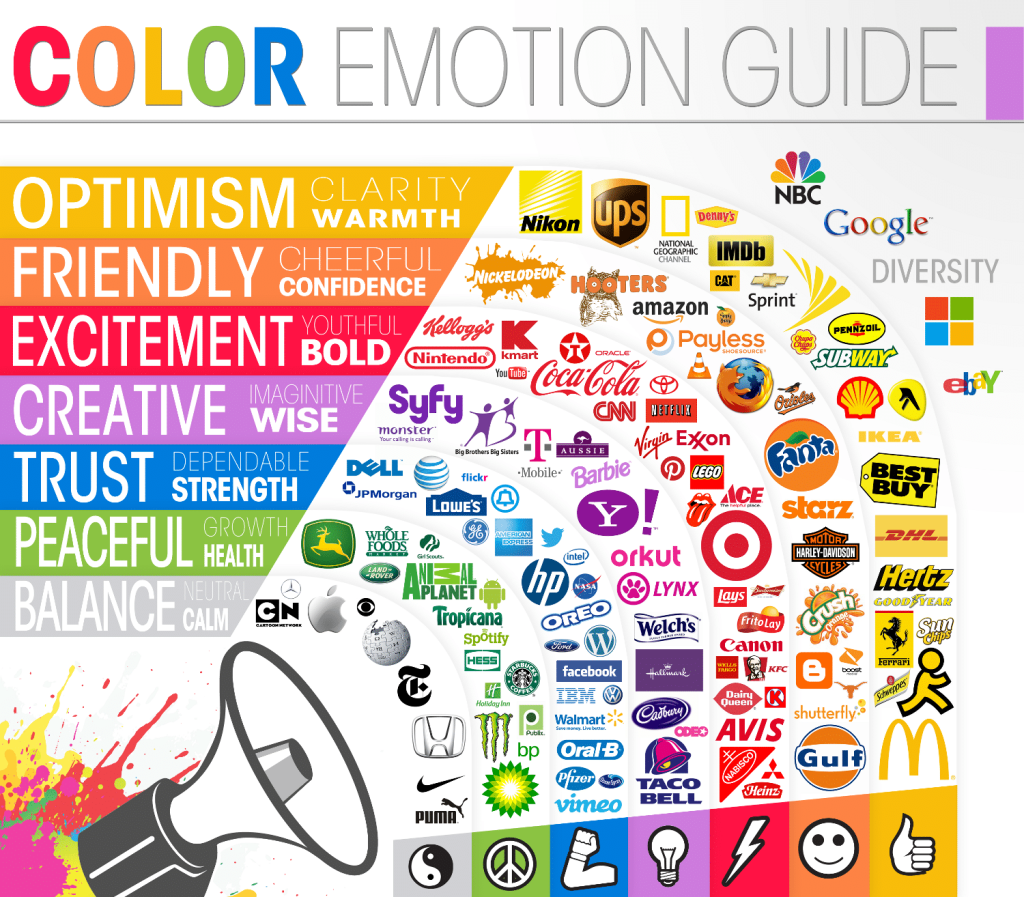You’ve got a great cybersecurity offering, but will anyone believe you? In a crowded market, how you communicate your cybersecurity software or services is just as important as the solution itself.
Marketing, at its core, is driven by psychology. It influences how people perceive your brand and make decisions. To rise above the noise in cybersecurity, understanding psychological factors is crucial for creating a brand that resonates with your audience. In this post, we explore how to leverage psychological insights to effectively communicate your cybersecurity solutions, build trust, and connect with your customers on a deeper level.
Trust Is the Cornerstone of Cybersecurity
The foundation of cybersecurity branding is trust, which is deeply rooted in human psychology. Trust is shaped by past experiences and emotions, and plays a critical role in how customers perceive a brand’s reliability. To understand what truly matters to decision-makers, we surveyed business leaders and asked, ‘When considering a cybersecurity solution, what factor is most important to you in marketing messages?’ An overwhelming 57% said trust and credibility. In an era of budget cutting, it was surprising to see only 2% prioritized pricing.

How to Leverage It:
Cybersecurity companies must prioritize branding strategies that communicate reliability and trustworthiness. This can be done through clear messaging and demonstrating expertise in the field. The way you present your company should evoke confidence, ensuring clients feel their business is in safe hands the moment they interact with your brand.
Fear Tactics Don’t Work Anymore
For years, fear-based messaging dominated the cybersecurity marketing world. But times are changing. People are no longer as responsive to fear as they once were. The truth is, most people who were motivated by fear have already taken action to protect themselves. Fear-based marketing can feel manipulative and even alienating, especially when it’s overused. Additionally, the self-positivity bias suggests that individuals believe bad things happen to others, not themselves. As a result, fear-driven campaigns may lead to skepticism rather than action.
How to Leverage It:
Shift from fear to empowerment. Instead of focusing on the risks of inaction, highlight the positive benefits of strong cybersecurity: peace of mind, productivity, and a sense of control. Your messaging should position your brand as a trusted partner in your customers’ ongoing success, showing them how your solutions help them stay ahead.
Social Proof: Humans Are Herd Animals
Humans tend to follow the crowd, and we often trust products or services based on the positive experiences of others. This is where social proof comes into play. Testimonials, case studies, and success stories are some of the best ways of showcasing real-life experiences with your brand. It’s no longer just about having a great solution. Your audience wants to see that others have successfully trusted you with their cybersecurity needs.

Source: Gartner Digital Markets
How to Leverage It:
Leverage the power of social proof by showcasing testimonials from satisfied clients, especially recognizable names in the industry. Highlight success stories that demonstrate how your cybersecurity solutions have prevented breaches or resolved major concerns. People are more likely to trust your brand if they see others have had a positive experience with it. Schedule a free consultation with our team to discuss how you can integrate social proof into your marketing efforts.
The Role of Visuals: Security Doesn’t Have to Be Boring
Your brand’s visual identity shapes how people perceive you. A bold, distinctive visual approach can set your brand apart and make a lasting impression. Here’s how color, fonts/typography, and graphics/images influence perception:
Color
Color plays a crucial role in shaping how customers perceive your brand. For example, blue is often associated with trust and reliability, which is why many tech and cybersecurity companies use it. Green, on the other hand, can suggest growth and innovation, making it a great choice for brands that want to stand out. Yellow is often linked to energy and optimism, helping to create a more approachable and engaging feel.

Source: The Logo Company
Fonts/Typography
Gone are the days of Times New Roman and other rigid, traditional fonts. Today, modern sans-serif fonts like Montserrat, Lato, and Inter are stealing the show, creating a cleaner, more approachable feel. Typography matters just as much as colour. Choosing the wrong font can make your brand feel outdated or untrustworthy.

Source: PMD Group
Graphics/Images
Move beyond generic stock images and overused lock icons. Visual consistency is key—animations and cartoonish figures can be hard to scale effectively across different mediums. While AI-generated images are improving, they often introduce inconsistencies like misspelled words or misplaced elements, making them unreliable for polished branding. Think about it—when you see an AI-generated image, you can usually tell right away.
How To Leverage It
The key to strong brand visuals is defining these elements early on. Color, typography, and imagery need to work together to create a cohesive identity. A modern, approachable font won’t be effective if it clashes with dark, intimidating graphics. Likewise, a vibrant color palette can feel off if paired with outdated typography. When these elements are aligned, they reinforce your brand’s personality and make a lasting impression. Take the time to establish your visual identity upfront, ensuring every touchpoint—from your website to your marketing materials—tells a consistent and compelling story.
The Importance of Simplicity: Reducing Cognitive Load
Cybersecurity is complex—and often filled with technical jargon. The human brain is wired to prefer simple, digestible information. Overloading potential clients with too many details can lead to cognitive overload, a state where too much information overwhelms the brain. This makes it difficult to process and retain key messages and can cause disengagement or a loss of interest entirely.
How to Leverage It:
Simplify your messaging by breaking down complex concepts into bite-sized, easy-to-understand pieces. Ditch the jargon and focus on what your audience truly cares about. Visuals and infographics are also powerful tools in communicating complex ideas clearly. By simplifying your message, you make it easier for potential clients to make informed decisions with confidence.
Examples of Simplified Cybersecurity Messaging:
Complex: “Our platform utilizes advanced encryption methodologies and zero-trust architecture to mitigate cybersecurity threats.”
Simple: “We keep your data safe, so only the right people can access it.”
Complex: “Our endpoint security solution employs behavioral analysis to detect and neutralize sophisticated malware variants in real time.”
Simple: “We stop cyber threats before they can harm your devices.”
Complex: “With real-time security monitoring and automated compliance reporting, our solution ensures adherence to industry regulations.”
Simple: “Stay compliant and more secure—without the hassle.”
Authority and Expertise: People Want the Best
When it comes to cybersecurity (or anything for that matter) customers want the best. Establishing authority and positioning your brand as an expert in the field is crucial for gaining trust and prompting action.
How to Leverage It:
Showcase your authority by prominently displaying certifications, industry partnerships, and awards. Position yourself as a thought leader through blogs, whitepapers, and speaking engagements. Create content that demonstrates your deep understanding of cybersecurity challenges and solutions. When your audience sees you as a trusted authority, they’ll feel more confident in choosing your brand.
The Power of Psychology in Cybersecurity Marketing
Effective cybersecurity branding goes beyond just logos and color palettes. It’s about understanding your audience’s fears, desires, and needs—and crafting messaging that resonates on an emotional, intellectual, and social level. By focusing on trust, simplicity, empowerment, social proof, and authority, you can build a brand that not only stands out in a crowded market but also fosters long-lasting relationships with your audience.
So, next time you think about your branding strategy, remember this: it’s not just about looking secure; it’s about making your audience feel secure. By tapping into these psychological triggers, your brand will not only be noticed—it will be trusted. And in the world of cybersecurity, trust is everything.
Ready to build a cybersecurity brand that truly connects? Schedule a free consultation to get started.
Let’s Work Together
Ready to grow your business? Let’s bridge the gap between your expertise and your ideal clients.